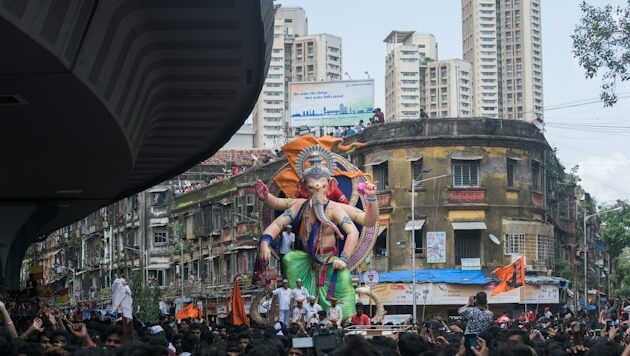
Ganesh Chaturthi, also known as Vinayaka Chaturthi, is one of the most extravagantly celebrated festivals in India, with Mumbai being the epicenter of its grandeur. This festival, which marks the birth of Lord Ganesha, the beloved elephant-headed deity, is observed with immense zeal and fervor. Devotees welcome Lord Ganesha into their homes and public pandals with grand processions, intricate decorations, and heartfelt prayers. The city’s streets are adorned with lights, colors, and an infectious festive spirit.
The History and Significance of Ganesh Chaturthi
The tradition of celebrating Ganesh Chaturthi dates back to the Maratha ruler Chhatrapati Shivaji Maharaj, who popularized the festival to instill a sense of unity among his people. However, the festival gained momentum as a public celebration in the late 19th century, thanks to freedom fighter Lokmanya Bal Gangadhar Tilak. He transformed it into a mass gathering to unite people against British rule. Today, the festival is a symbol of devotion, art, and cultural heritage in Mumbai and across Maharashtra.
Preparations and Festivities in Mumbai
The preparations for Ganesh Chaturthi in Mumbai begin months in advance. Skilled artisans craft breathtaking Ganesha idols from clay, Plaster of Paris (PoP), and eco-friendly materials. These idols range from a few inches to towering structures over 20 feet high. The pandals (temporary temples) are constructed with intricate themes, some resembling mythological stories, historical events, or social messages.
Pandal Decorations and Competitions
Mumbai is known for its elaborately decorated pandals, where thousands of devotees gather for darshan (viewing of the idol). Some of the most famous Ganesh Pandals in Mumbai include:
- Lalbaugcha Raja – The most famous and revered Ganesh idol, attracting millions of devotees.
- Ganesh Galli Mumbaicha Raja – Known for its unique themes and grand decorations.
- Khetwadi Ganraj – Famous for hosting some of the tallest Ganesh idols.
- GSB Seva Mandal – Known as the richest Ganesh Pandal, with gold and silver decorations.
- Andhericha Raja – Popular for fulfilling devotees’ wishes.
Each of these pandals is a work of art, often depicting elaborate mythological and contemporary themes, making them an unmissable attraction during the festival.
Rituals and Celebrations
The festival lasts for 10 days, beginning with Ganesh Sthapana (idol installation) on Ganesh Chaturthi and concluding with Ganesh Visarjan (idol immersion) on Anant Chaturdashi.
Ganesh Sthapana (Installation Ceremony)
The festival commences with the installation of Lord Ganesha’s idol in homes and public pandals. Devotees perform pranapratishtha, invoking the deity’s presence through Vedic chants and rituals. Offerings such as modaks, ladoos, coconuts, durva grass, and flowers are made to the deity.
Daily Aartis and Prayers
Throughout the 10 days, devotees perform morning and evening aartis with fervent chants of Ganpati Bappa Morya! The atmosphere is filled with the rhythmic beats of drums, devotional songs, and traditional instruments like dhol-tasha.
Some of the most popular aartis include:
- Sukhakarta Dukhaharta
- Jai Ganesh Jai Ganesh Deva
- Ganpati Atharvashirsha
Ganesh Visarjan: The Grand Farewell

The culmination of the festival is the Ganesh Visarjan, where devotees bid an emotional farewell to Lord Ganesha. This day witnesses massive processions, with lakhs of people dancing to the beats of dhol-tasha while chanting “Ganpati Bappa Morya, Pudhchya Varshi Lavkar Ya” (O Lord Ganesha, come back soon next year!).
The immersion sites in Mumbai include:
- Girgaum Chowpatty – The most famous visarjan spot.
- Juhu Beach – A popular location for immersion.
- Versova Beach – Preferred for eco-friendly immersions.
- Powai Lake – A serene and less crowded visarjan location.
- Aarey Colony – Encourages eco-friendly visarjan practices.
Eco-Friendly Ganesh Chaturthi
In recent years, there has been a strong movement towards celebrating Ganesh Chaturthi in an eco-friendly manner. Traditional idols made from Plaster of Paris (PoP) and synthetic paints have caused water pollution, harming marine life. Many Mumbaikars have now adopted eco-friendly idols made of clay and biodegradable materials. Several organizations promote artificial tanks for visarjan to prevent pollution in natural water bodies.
Ways to Celebrate a Sustainable Ganesh Chaturthi
- Opt for clay idols that dissolve easily in water.
- Use natural colors and biodegradable decorations.
- Encourage home visarjan instead of public immersions.
- Avoid plastic and thermocol-based decorations.
- Participate in clean-up drives after visarjan.
Food and Sweets During Ganesh Chaturthi
No Indian festival is complete without delicious food, and Ganesh Chaturthi is no exception. The most loved sweet of this festival is Modak, believed to be Lord Ganesha’s favorite. Other festive delicacies include:
- Ukadiche Modak – A steamed rice flour dumpling filled with coconut and jaggery.
- Fried Modak – A crispy variation of the traditional modak.
- Puran Poli – A sweet flatbread filled with jaggery and lentils.
- Satori – A Maharashtrian festive sweet made of khoya.
- Shrikhand – A sweetened yogurt dessert.
- Basundi – A thickened milk dessert served with nuts.
Ganesh Chaturthi Beyond Mumbai
While Mumbai hosts the grandest Ganesh Chaturthi celebrations, the festival is also celebrated with great enthusiasm in other parts of India, including:
- Pune – Known as the birthplace of the public Ganesh festival.
- Hyderabad – Home to the iconic Khairatabad Ganesh.
- Goa – Celebrated with traditional rituals and folk dances.
- Tamil Nadu & Karnataka – Marked by home pujas and temple festivities.
- Delhi & Kolkata – Emerging as major hubs for grand celebrations.
Conclusion
Ganesh Chaturthi in Mumbai is not just a festival; it is an emotion, a cultural spectacle, and a vibrant celebration of devotion and artistry. The city comes alive with elaborate decorations, heartwarming prayers, and grand processions, making it an unforgettable experience. As Mumbai embraces a more sustainable approach to celebrating, the festival continues to evolve, ensuring that devotion and environmental consciousness go hand in hand.